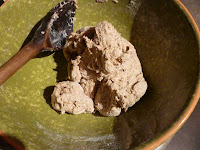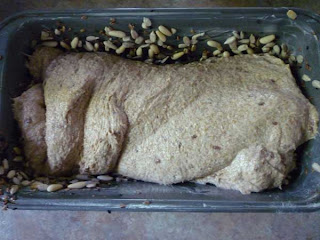Time for another Reinhart loaf. I've been putting this one off for some time, thinking that I would have a hard time finding the Oat Bran that the recipe requires. But I found some easily in the bulk food section of my local grocery store.
There was not that much to learn here. The technique is the same, it takes 2 days to make.
The Soaker:
This is simply mixed up and set aside for 12-24 hours. No yeast.
The Biga:
This is mixed too; but it contains yeast, so it requires a few minutes of kneading.
After you mix it, you knead it 2 minutes, rest for 5 minutes.
You knead again for 1 minute, and then put it in a container for the fridge, where it sits 8 hours.
This was a very wet pre-dough biga. I did knead it on the counter for the first minute or so, but then I found it easier to knead in the bowl with one hand, turning the bowl 90 degrees each time I stretched the dough. That worked better.
Final Dough:
The biga comes out of the fridge 2 hours before you want to use it. You cut it and the soaker into 12 parts, and toss it all together with the other ingredients. This again is a wet dough, and I found it easier to knead in the bowl one handed, like before. Once mixed, with wet hands, I kneaded in the bowl for 3-4 minutes, rested 5 minutes, and kneaded 1 minute more. Then I set it aside for an hour, and it rose appreciably.
Forming the dough into a loaf was done with the pastry cutter, on the counter. I didn't use any more flour on the counter, but used the stickiness of the dough to pull the dough in each of the 4 directions, one after another. Then I used Reinhart's methods of forming for the loaf pan. The tricky part was getting it into the loaf pan, since this dough is so wet. I thought that the twist I gave the dough when it landed in the pan was going to give me trouble. But I poured the seeds in the bottom of the greased pan, and over the top of the loaf, and set it to proof for an hour. Seeds I used:
- sunflower seeds
- black sesame seeds
- brown flax seeds
- pine nuts
I was amazed at how much it rose during the proofing stage. The dough was very fragile at this point; the seeds jiggled as I moved the pan into the preheated oven. And it baked up nicely (although there was no oven spring; if anything, it might even have fallen a tiny bit).
This bread worried me, since it appeared to collapse in the middle in the day it sat on the counter prior to my cutting into it. However, it was cooked. And this is a loaf that my wife likes (although she doesn't rave about it).
The Crumb Shot:
Notes to Myself:
- The seeds were not toasted prior to using them, and they were not incorporated into the dough but rather used to line the pan and top of the loaf. This isn't exactly what the recipe called for, but it worked in this case (although probably 20 g fell off in transit).
- This wet dough was mostly kneaded in the bowl, and that worked good, in this case.
- Using no flour on the counter surface enabled me to pull the bottom of the dough outward and upward over the top of the dough, in each of 4 directions, which helped the dough gain elasticity. This worked nicely.
- Getting the formed dough into the pan was a bit of a struggle, and the dough spiraled a bit as it flopped into the pan. Better might have been to use the big metal pizza peel to move the dough. But it turned out that the dough was so well prepared during the forming stage, it didn't matter so much, it proofed nicely.






















No comments:
Post a Comment